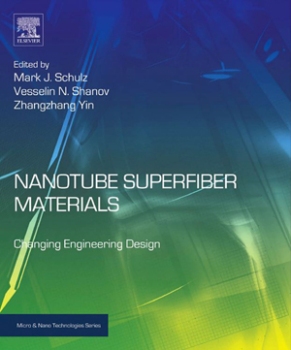Feb 11 2014
University of Cincinnati College of Engineering and Applied Science (CEAS) renowned researchers Mark J. Schulz, Vesselin N. Shanov, and Zhangzhang Yin continue to garner attention for their work in the field of nanotube fiber materials. They’re specifically catching the eye of Wayne Yuhasz, an editor at Elsevier, who approached the team and asked them if they were interested in producing a book for the Elsevier Micro & Nano Technologies Series. Schulz, Shanov and Yin accepted the challenge.
 Cover of the book, Nanotube Superfiber Materials: Changing Engineering Design.
Cover of the book, Nanotube Superfiber Materials: Changing Engineering Design.
Shortly thereafter, the researchers submitted a book proposal which was then reviewed by six experts who suggested improvements. Upon signing a contract to produce the book, Schulz, Shanov and Yin invited experts from around the world to contribute chapters. Two years later, the book, "Nanotube Superfiber Materials: Changing Engineering Design," was finished.
Schulz describes “Nanotechnology is engineering using nanoscale materials. Nanoscale materials have large surface area to volume ratios and often have new properties and better properties than macroscale bulk materials. Therefore, materials and machines that have ‘nano inside’ can have better performance than conventional materials. This makes nanotechnology useful and needed to provide improved technology for society in almost all areas including engineering materials, medicine, computers, health products, sensors and more.”
Their book is the first to comprehensively explore the production and applications of macro-scale materials made from nano-scale particles. It outlines the processes for producing macro-scale materials from carbon nanotubes and describes the unique properties of these materials. The book highlights potential applications for carbon nanotube fiber/yarn including replacing copper wire for power conduction, EMI shielding, coax cable, carbon biofiber, bullet-proof vests, impact resistant glass, wearable antennas, biomedical microdevices, biosensors, self-sensing composites, supercapacitors, superinductors, hybrid superconductor, reinforced elastomers, nerve scaffolding, energy storage, and many others.
Schulz explains, “Nanotube fiber materials are going to change engineering design in many ways. This is the first book to focus on nanotube fiber or we call it superfiber materials. We hope the book accelerates nanotube fiber research and applications. It benchmarks where we are now and the chapter authors suggest paths to go forward.
We also hope further collaborations occur in the field. The book helps show the importance and potential of the field and hopefully, may encourage more funding for research and support of undergraduate and graduate students to do research.”
UC has been involved in nanotechnology for 15 years, with CEAS significantly beginning its research in 2000. CEAS’ nanotechnology program is a leader nationally and globally because its researchers do full circle research. Full circle means that researchers synthesize carbon nanotubes, and recently graphene; they characterize the material; post-process the material; and use the different forms of material in various applications. Then UC researchers go back to iterate and improve the material for specific applications. Not all universities have the comprehensive facilities, manpower and expertise to design, synthesize, and apply nanoscale materials like UC does.
Schulz and Shanov formed the Nanoworld Lab at UC (http://www.min.uc.edu/nanoworldsmart). They refer to it as being the university lab because many faculty members across UC collaborate on projects and focus on several areas of research that are supported by its facilities.
Nanotechnology research is conducted in various disciplines, such as aerospace, biomedical, civil, computer, electrical, mechanical engineering, and also, in medicine. Nanoscale materials improve the properties of composite materials and plastics which can eventually be used in the production of airplanes, automobiles, and sporting equipment that are lighter, save fuel, and reduce pollution. Nanoparticles are being used in medicine for cancer diagnosis and therapy. Schulz believes nanomedicine will prove to be an extraordinary benefit to society.
UC is hosting the “2014 Nanotechnology Materials and Devices (NMD) Workshop” from February 24- 25, 2014 in the West Campus Tangeman University Center Great Hall. The workshop is sponsored by the UC Office of Research, the University of Dayton Research Institute, and the Air Force Research Laboratory along with industrial partners. NMD speakers are some of the best experts in the field and most of them are also contributors to the researchers’ book.
The intensive single track workshop consists of invited talks and laboratory tours. It covers the synthesis, functionalization, characterization, modeling, post processing and application of carbon nanostructured materials and devices. The goal of the workshop is to benchmark the current state of the art and develop plans to make breakthroughs in engineering materials and devices based on nanotechnology. The electronic, thermal and mechanical properties of carbon nanotubes and spun thread are of particular interest. Applications of nanotechnology and industry needs will be discussed along with strategies for commercializing nanotechnology.
Additionally, the workshop provides opportunities to establish cooperative research and to intersect different ideas in order to break down barriers in nanotechnology. We hope to see you there so that you can witness the future of engineering along with us!
For more information about the NMD Workshop, please select: NMD Schedule of Events
For more information about nanotechnology at UC, please select: http://ceas.uc.edu/news-1213/uc-engineers-in-nanospace.html
For more information about UC NanoWorld, please select: http://www.min.uc.edu/nanoworldsmart